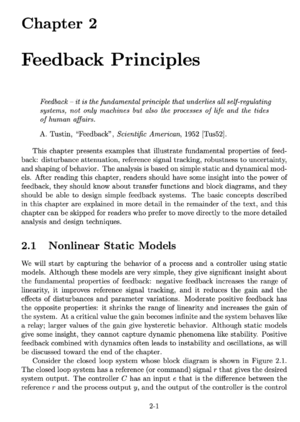Difference between revisions of "Feedback Principles"
(Created page with "{{Chapter |Chapter number=2 |Next chapter=System Modeling |Previous chapter=Introduction |Chapter summary=This chapter presents examples that illustrate fundamental properties...") |
m (fix hyphenation) |
||
| (5 intermediate revisions by the same user not shown) | |||
| Line 1: | Line 1: | ||
{{Chapter | {{Chapter | ||
|Chapter number=2 | |Chapter number=2 | ||
| + | |Short name=principles | ||
| + | |Previous chapter=Introduction | ||
|Next chapter=System Modeling | |Next chapter=System Modeling | ||
| − | | | + | |First edition URL=None |
| − | |Chapter summary=This chapter presents examples that illustrate fundamental properties of | + | |Chapter summary=This chapter presents examples that illustrate fundamental properties of feedback: disturbance attenuation, reference signal tracking, robustness to uncertainty, and shaping of behavior. The analysis is based on simple static and dynamical models. After reading this chapter, readers should have some insight into the power of feedback, they should know about transfer functions and block diagrams, and they should be able to design simple feedback systems. The basic concepts described in this chapter are explained in more detail in the remainder of the text, and this chapter can be skipped for readers who prefer to move directly to the more detailed analysis and design techniques. |
| − | |Chapter contents=# Nonlinear Static Models | + | |Chapter contents=# Nonlinear Static Models |
| + | #* Response to Reference Signals | ||
| + | #* Robustness to Parameter Uncertainty | ||
| + | #* Load Disturbance Attenuation | ||
# Linear Dynamical Models | # Linear Dynamical Models | ||
| + | #* Linear Differential Equations and Transfer Functions | ||
| + | #* Stability: The Routh--Hurwitz Criterion | ||
| + | #* Block Diagrams and Transfer Functions | ||
| + | #* Computations Using Transfer Functions | ||
# Using Feedback to Attenuate Disturbances | # Using Feedback to Attenuate Disturbances | ||
| + | #* Proportional Control | ||
| + | #* Proportional-Integral (PI) Control | ||
| + | #* Unmodeled Dynamics | ||
# Using Feedback to Track Reference Signals | # Using Feedback to Track Reference Signals | ||
| + | #* Controllers with Two Degrees of Freedom | ||
# Using Feedback to Provide Robustness | # Using Feedback to Provide Robustness | ||
| + | #* Reducing Effects of Parameter Variations and Nonlinearities | ||
| + | #* Nonlinear Analysis and Approximations | ||
# Positive Feedback | # Positive Feedback | ||
| + | #* Hewlett's Oscillator | ||
| + | #* Implementation of Integral Action by Positive Feedback | ||
| + | #* Positive Feedback Combined with Saturation | ||
# Further Reading | # Further Reading | ||
:: Exercises | :: Exercises | ||
}} | }} | ||
| + | {{Chapter footer}} | ||
Latest revision as of 01:40, 29 May 2022
| Prev: Introduction | Chapter 2 - Feedback Principles | Next: System Modeling |
This chapter presents examples that illustrate fundamental properties of feedback: disturbance attenuation, reference signal tracking, robustness to uncertainty, and shaping of behavior. The analysis is based on simple static and dynamical models. After reading this chapter, readers should have some insight into the power of feedback, they should know about transfer functions and block diagrams, and they should be able to design simple feedback systems. The basic concepts described in this chapter are explained in more detail in the remainder of the text, and this chapter can be skipped for readers who prefer to move directly to the more detailed analysis and design techniques.
Teaching MaterialsNone available Additional ExercisesNone available Frequently Asked QuestionsNone available ErrataNone reported |
Python CodeThe following Python scripts are available for producing figures that appear in this chapter.
See the software page for more information on how to run these scripts. Additional Information |
